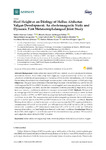Heel Height as an Etiology of Hallux Abductus Valgus Development: An electromagnetic Static and Dynamic First Metatarsophalangeal Joint Study

Use este enlace para citar
http://hdl.handle.net/2183/29964Colecciones
- Investigación (FEP) [504]
Metadatos
Mostrar el registro completo del ítemTítulo
Heel Height as an Etiology of Hallux Abductus Valgus Development: An electromagnetic Static and Dynamic First Metatarsophalangeal Joint StudyAutor(es)
Fecha
2019Cita bibliográfica
Sánchez-Gómez, R.; Becerro de Bengoa-Vallejo, R.; Losa-Iglesias, M.E.; Calvo-Lobo, C.; Romero-Morales, C.; Martínez-Jiménez, E.M.; Palomo-López, P.; López-López, D. Heel Height as an Etiology of Hallux Abductus Valgus Development: An electromagnetic Static and Dynamic First Metatarsophalangeal Joint Study. Sensors 2019, 19, 1328. https://doi.org/10.3390/s19061328
Resumen
[Abstract] Background: Hallux abductus valgus (HAV) is a forefoot condition produced by extrinsic and intrinsic factors. Shoes with a high heel height and a typical narrow tip toe box can induce deviations in both the proximal phalanx of the hallux (PPH) and the first metatarsal (IMTT) bones. Nevertheless, the isolated role of heel height remains unclear in the development of HAV pathology. Objectives: The goal was to determine if the heel height increase of shoes without a narrow box toe could augment the PPH and IMTT deviation in frontal, sagittal, and transverse planes toward the first metatarsophalangeal joint (MPJ) and the first metatarsocuneiform joint (MCJ), respectively, during static and dynamic conditions in relation to precursor movements of HAV. Methods: Women with an average age of 25.10 ± 4.67 years were recruited in this cross-sectional study to assess the three planes of motion of PPH and IMTT while wearing high heels with heights at 3, 6, 9 cm and unshod conditions via sandals. The measurements used an electromagnetic goniometer device with sensors placed on medial aspects of the PPH and IMTT bones under static and dynamic conditions. Results: Wearing shoes with a 6 cm heel in dynamic condition may increase the PPH valgus and abduction deviation from 3.15 ± 0.10° to 3.46 ± 0.05° (p < 0.05) and from 1.35 ± 0.28° to 1.69 ± 0.30° (p < 0.001), respectively. In addition, a PPH abduction increase from 1.01 ± 0.36° to 1.31 ± 0.46° (p < 0.05) after wearing shoes with a 6 cm heel height was observed under static conditions. Conclusions: Wearing shoes with a heel height of 6 cm without a narrow box toe interference may produce PPH abduction and valgus deviations related to HAV formation.
Palabras clave
Hallux abductus valgus
High heel
Tacones
Proximal phalanx of the hallux
Falange proximal del hallux
Abduction
Abducción
Valgus
High heel
Tacones
Proximal phalanx of the hallux
Falange proximal del hallux
Abduction
Abducción
Valgus
Versión del editor
Derechos
Atribución 3.0 España






